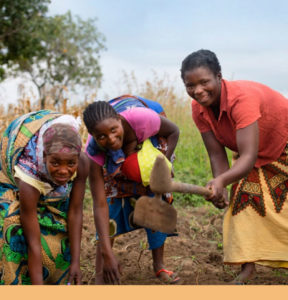A food-systems approach to vitamin A deficiency
2021 marks the mid-point of the UN Decade of Action on Nutrition and a critical pivot point for governments, development partners, and business leaders to step up action to eliminate malnutrition in all its forms. This first feature story in the CIP@50 series looks at how the vitamin-A-rich, orange-fleshed sweetpotato delivers on nutrition, climate, and inclusive growth. This triple-win makes it the perfect tool to help transform food systems to be healthier, more sustainable, and resilient.
A food-systems approach to vitamin A deficiency
“Because I know orange-fleshed sweetpotato is good for our health, I make sure that we have it on our plates every day,” says Marie Claire Mukakimenyi, a farmer and widowed mother of five in central Rwanda. Marie Claire is one of the millions of farmers who have benefitted from a transformative program, led by the CGIAR’s International Potato Center (CIP), to expand production and consumption of orange-fleshed sweetpotato to reduce vitamin A deficiency.
Vitamin A deficiency is devastating. It is the world’s leading cause of blindness and affects more than 140 million children globally. And yet just one small, easy-to-grow biofortified orange-fleshed sweetpotato can provide one child’s daily vitamin A needs. Through the work of CIP and our partners, this nutritious tuber has reached more than seven million households across Africa and South Asia, gaining international recognition along the way.
Getting to the root of the solution
White-fleshed sweetpotato varieties dominate in Africa and South Asia but they lack the high levels of beta carotene which are abundant in their orange-fleshed relatives (beta carotene is an orange pigment the body converts to Vitamin A). Seeing the potential these varieties could bring to fill micronutrient gaps, CIP scientists began working with national crop breeding institutes to establish populations of beta-carotene-rich, orange-fleshed varieties. Due to its genetic complexity, the sweetpotato is a difficult crop to improve, but programs in 20 countries in Africa and South Asia have managed to breed and release more than 100 orange-fleshed sweetpotato varieties over the past decade.
“Once those seeds, those varieties, are in the food system, they are available year after year, delivering nutrients, resilience, and improved livelihoods,” explains Jan Low, Senior Scientist at CIP. “But to ensure they become embedded in local food systems, you cannot simply introduce new varieties or swap one with another. It is critical to get buy-in from target communities by gathering user feedback and building those preferences into breeding programs to ensure uptake.”
Simon Heck, Program Leader, agrees. “Consumer feedback told us quite early on in the program that in places where people eat sweetpotato mainly boiled, they did not like some of the early varieties. They were much softer than the firm white sweetpotato they were used to. So our breeders focused on increasing the dry matter content. Interestingly, the softer varieties are now preferred for other uses that have emerged, such as processing them into puree to use in other dishes.”
Varieties must also meet farmer needs when it comes to growing well in harsh environments. Sweetpotato is quick growing which reduces the risk of crop failure. Fortunately, sweetpotato is affordable, adapts well to growing at different altitudes, and is climate-resilient. These qualities make it attractive for farmers to grow as it can bring reliable and quick returns at the market, particularly when accompanied by efforts to increase consumer demand.
A healthy serving in markets, schools, and bakeries.
From the start of CIP’s work with orange-fleshed sweetpotato, its introduction into the wider food system has been accompanied by promotional campaigns to drive its use in school lunch programs, rural markets, supermarkets, health clinics, and backyard garden programs. In cooperation with government agencies, it has also a key food item in some prenatal and mother-baby wellness programs in rural health centers.
Converting the nutritious orange-fleshed sweetpotato into puree means it can be used in products like bread and biscuits, creating new income and employment opportunities across rural and urban communities and increasing its consumption by target communities. CIP has worked with food companies in several African countries to promote its production and use as a substitute for up to 50% of the flour in bakery products. The pastries and breads are not only healthier but they save businesses money as much flour in the region must be imported.
What next for the orange-fleshed sweetpotato?
Recognized by the World Food Prize in 2016 as the “single most successful example of biofortification,” the role of orange-fleshed sweetpotato in global diets will only continue to grow. Breakthroughs in breeding techniques and new partnerships with major food companies in Kenya and South Africa are just a couple examples of how sweetpotato will take a larger place on the tables, farms, and markets for many more millions of families needing improved nutrition.
Recently, sweetpotato has become an important tool in humanitarian relief. After a cyclone-ravaged Mozambique in 2019, CIP and the International Red Cross provided quick-growing sweetpotato to disaster-struck families. Last year, in collaboration with the World Food Programme, CIP distributed sweetpotato to more than 300,000 families in climate-, conflict-, and displacement-affected regions in Asia and Africa. By leveraging partnerships such as this, Heck says, sweetpotato is firmly earning its place as one of the strategic assets that the One CGIAR will deploy in its mission to drive food systems transformation toward the 2030 Sustainable Development Goals.
“Its strengths as a highly-effective delivery system for vitamin A and low-input crop that grows well on difficult farmland means its ideally suited to help vulnerable communities around the world improve their diets.”

